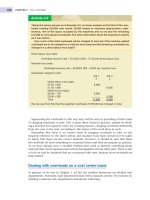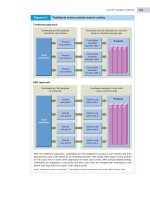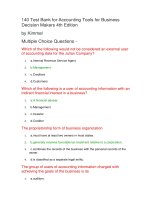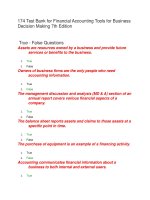Managerial economics economic tools for todays decision makers 7th edtion by keat young and erfle chapter 03
Bạn đang xem bản rút gọn của tài liệu. Xem và tải ngay bản đầy đủ của tài liệu tại đây (318.03 KB, 42 trang )
Chapter 3
Supply and
Demand
Chapter Outline
•
•
•
•
•
Market demand
Market supply
Market equilibrium
Comparative statics analysis
Supply, demand, and price
Copyright ©2014 Pearson Education, Inc. All rights reserved.
3-2
Learning Objectives
• Define supply, demand, and equilibrium price
• List and provide specific examples of the non-price
determinants of supply and demand
• Distinguish between the short-run rationing function
and long-run guiding function of price
• Illustrate how the concepts of supply and demand
can be used in management decisions about price
and allocations of resources.
• Use supply and demand diagrams to determine
price in the short and long run
Copyright ©2014 Pearson Education, Inc. All rights reserved.
3-3
Market Demand
• The demand for a good or service is defined as:
– Quantities of a good or service that people are
ready, willing and able to buy at various prices
within some given time period. (Other factors
besides price held constant.)
Copyright ©2014 Pearson Education, Inc. All rights reserved.
3-4
Market Demand
• “Ready” implies that consumers are prepared to
buy a good or service both because they are:
– Willing: Consumers have a preference for it.
– Able: Consumers have the income to support this
preference.
Copyright ©2014 Pearson Education, Inc. All rights reserved.
3-5
Market Demand
Market demand is the sum of all the individual
demands.
• Individuals may have distinct demand curves,
and they sum to the overall demand in the
market.
Example: demand for pizza
Copyright ©2014 Pearson Education, Inc. All rights reserved.
3-6
Market Demand
There is an inverse
relationship between
price and the quantity
demanded of a good or
service.
This is called the Law
of Demand.
Thus, the demand
curve is downward
sloping.
Copyright ©2014 Pearson Education, Inc. All rights reserved.
3-7
Market Demand
• Graphical
Representation of
Demand
• Algebraic
Representation of
Demand
Qd=700-100P
Copyright ©2014 Pearson Education, Inc. All rights reserved.
3-8
Market Demand
• Changes in price result in changes in the quantity
demanded
– This is shown as movement along the demand
curve.
• Changes in non-price factors result in changes in
demand
– This is shown as a shift in the demand curve.
Copyright ©2014 Pearson Education, Inc. All rights reserved.
3-9
Market Demand
Copyright ©2014 Pearson Education, Inc. All rights reserved.
3-10
Market Demand
• Non-price determinants of demand-result is a shift
in the demand curve.
–
–
–
–
–
tastes and preferences
income
prices of related products
future expectations
number of buyers
Copyright ©2014 Pearson Education, Inc. All rights reserved.
3-11
Market Supply
• The supply of a good or service is defined as
quantities that people are ready to sell at various
prices within some given time period
(Other factors besides price held constant)
Copyright ©2014 Pearson Education, Inc. All rights reserved.
3-12
Market Supply
• Changes in price result in changes in the quantity
supplied
– shown as movement along the supply curve
• Changes in non-price determinants result in
changes in supply
– shown as a shift in the supply curve
Copyright ©2014 Pearson Education, Inc. All rights reserved.
3-13
Market Supply
Copyright ©2014 Pearson Education, Inc. All rights reserved.
3-14
Market Supply
• Non-price determinants of supply-results in a shift in
the supply curve.
– costs and technology
– prices of other goods or services offered by the
seller
– future expectations
– number of sellers
– weather conditions
Copyright ©2014 Pearson Education, Inc. All rights reserved.
3-15
Market Equilibrium
• Equilibrium price: the price that equates the
quantity demanded with the quantity supplied
• Equilibrium quantity: the amount that people are
willing to buy and sellers are willing to offer at the
equilibrium price level
Copyright ©2014 Pearson Education, Inc. All rights reserved.
3-16
Market Equilibrium
• Shortage: a market situation in which the quantity
demanded exceeds the quantity supplied
– shortage occurs at a price below the equilibrium
level
• Surplus: a market situation in which the quantity
supplied exceeds the quantity demanded
– surplus occurs at a price above the equilibrium
level
Copyright ©2014 Pearson Education, Inc. All rights reserved.
3-17
Market Equilibrium
Copyright ©2014 Pearson Education, Inc. All rights reserved.
3-18
Comparative Statics Analysis
• Comparative statics is a form of sensitivity (or
what-if) analysis
– Commonly used method in economic analysis
Copyright ©2014 Pearson Education, Inc. All rights reserved.
3-19
Comparative Statics Analysis
• Process of comparative statics analysis:
– state all the assumptions needed to construct the
model
– begin by assuming that the model is in
equilibrium
– introduce a change in the model, so a condition
of disequilibrium is created
– find the new point of equilibrium
– compare the new equilibrium point with the
original one
Copyright ©2014 Pearson Education, Inc. All rights reserved.
3-20
Comparative Statics Analysis
Step 1
• assume all factors
except the price of
pizza are constant
• buyers’ demand and
sellers’ supply are
represented by lines
shown
Copyright ©2014 Pearson Education, Inc. All rights reserved.
3-21
Comparative Statics Analysis
Step 2
• begin the analysis in
equilibrium as shown
by Q1 and P1
Copyright ©2014 Pearson Education, Inc. All rights reserved.
3-22
Comparative Statics Analysis
Step 3
• assume that a new
study shows pizza to
be the most nutritious
of all fast foods
• consumers increase
their demand for pizza
as a result
Copyright ©2014 Pearson Education, Inc. All rights reserved.
3-23
Comparative Statics Analysis
Step 4
• the shift in demand
results in a new
equilibrium price (P2)
• and a new equilibrium
quantity (Q2)
Copyright ©2014 Pearson Education, Inc. All rights reserved.
3-24
Comparative Statics Analysis
Step 5
• comparing the new
equilibrium point with
the original one, we
see that both
equilibrium price and
quantity have
increased
Copyright ©2014 Pearson Education, Inc. All rights reserved.
3-25









